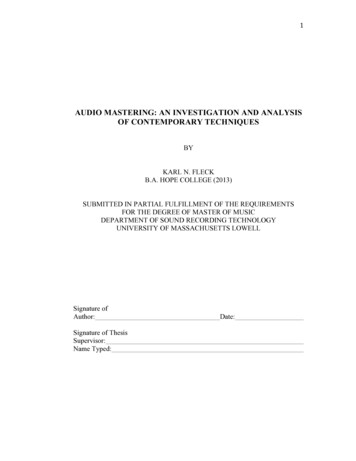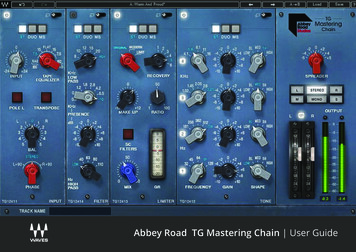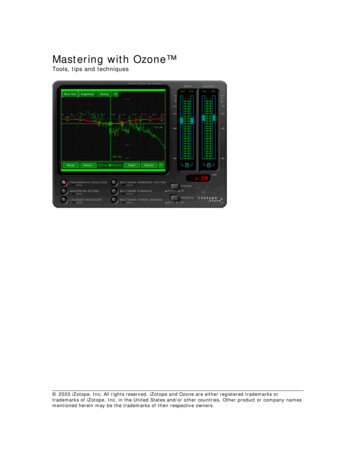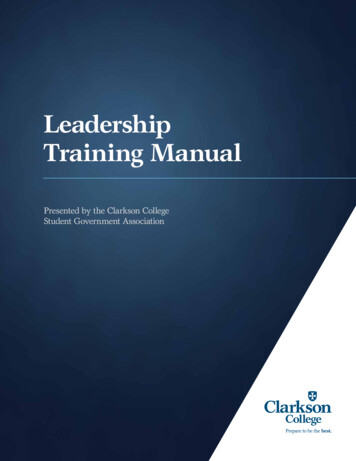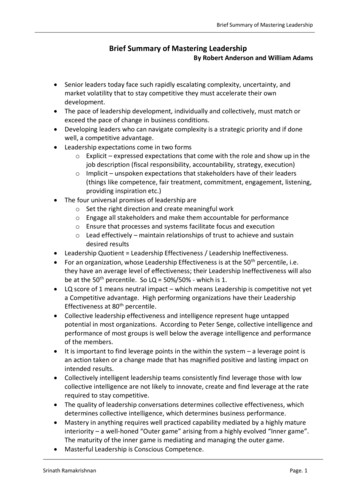
Transcription
Brief Summary of Mastering LeadershipBrief Summary of Mastering LeadershipBy Robert Anderson and William Adams Senior leaders today face such rapidly escalating complexity, uncertainty, andmarket volatility that to stay competitive they must accelerate their owndevelopment.The pace of leadership development, individually and collectively, must match orexceed the pace of change in business conditions.Developing leaders who can navigate complexity is a strategic priority and if donewell, a competitive advantage.Leadership expectations come in two formso Explicit – expressed expectations that come with the role and show up in thejob description (fiscal responsibility, accountability, strategy, execution)o Implicit – unspoken expectations that stakeholders have of their leaders(things like competence, fair treatment, commitment, engagement, listening,providing inspiration etc.)The four universal promises of leadership areo Set the right direction and create meaningful worko Engage all stakeholders and make them accountable for performanceo Ensure that processes and systems facilitate focus and executiono Lead effectively – maintain relationships of trust to achieve and sustaindesired resultsLeadership Quotient Leadership Effectiveness / Leadership Ineffectiveness.For an organization, whose Leadership Effectiveness is at the 50th percentile, i.e.they have an average level of effectiveness; their Leadership Ineffectiveness will alsobe at the 50th percentile. So LQ 50%/50% - which is 1.LQ score of 1 means neutral impact – which means Leadership is competitive not yeta Competitive advantage. High performing organizations have their LeadershipEffectiveness at 80th percentile.Collective leadership effectiveness and intelligence represent huge untappedpotential in most organizations. According to Peter Senge, collective intelligence andperformance of most groups is well below the average intelligence and performanceof the members.It is important to find leverage points in the within the system – a leverage point isan action taken or a change made that has magnified positive and lasting impact onintended results.Collectively intelligent leadership teams consistently find leverage those with lowcollective intelligence are not likely to innovate, create and find leverage at the raterequired to stay competitive.The quality of leadership conversations determines collective effectiveness, whichdetermines collective intelligence, which determines business performance.Mastery in anything requires well practiced capability mediated by a highly matureinteriority – a well-honed “Outer game” arising from a highly evolved “Inner game”.The maturity of the inner game is mediating and managing the outer game.Masterful Leadership is Conscious Competence.Srinath RamakrishnanPage. 1
Brief Summary of Mastering Leadership Competency alone does not make for effective leadership. When we describe greatleadership, we describe something beyond skills, capability, competence – we usewords like integrity, honesty, passion, vision, risk-taking, fearlessness, compassion,courage, authenticity, self-awareness, purposefulness, humility, intuition andwisdom – these are qualities of the inner game.Today’s Leaders need to be effective in 3 areaso Leadership Process – this is the science of leadership and the domain ofmanagement. Leaders are responsible for the allocation and effectiveutilization of resources – people, money and time.o Leadership Competencies – These are the competencies required for a leaderto be successful. This is the “Outside game” of leadershipo Leadership Consciousness – This is the “Inside game” of leadership – theleader’s inner operating system as to what drives the leader, how they definethemselves, what is important to them and what they believe. The Innergame consists of Our meaning making system – what we use to make sense of theworld Our decision-making system – how we analyze, decide and act Our values and spiritual beliefs Our level of self-awareness and emotional intelligence The mental models that we use to understand reality, think and actand create The internal beliefs and assumptions making up our personal identity. A break through in the Inner game can result in sudden shifts in theeffectiveness of the Outer game – which in turn can result in bigperformance gains.Four Foundational Premises Structure determines performanceo This is a systems and design principle.o The design of any system is the primary determinant of the performance ofthat system. Design, its operating possibilities and limits and not the driver,primarily determines its performanceYou are a structureo You have a mind for thinking and a body for acting.o You have an inner game and an outer game and both have a structure tothem.o The inner game is a complex system that includes your conscious andunconscious meaning and decision making system, values, mental models,beliefs, assumptions, self-awareness, emotional intelligence and identity.This is the internal operating system which functions like the computer’soperating system operating below the surface, mediating and managingeverything going on at the surface in the outer game.o Upgrades to the operating system enable us to be more effectiveConsciousness is the operating system of performanceo Consciousness (the inner game) is the deep structure of performance.Srinath RamakrishnanPage. 2
Brief Summary of Mastering Leadership o The structure of our operating system focuses our attention, influences ourchoices, drives our behavior and determines the effectiveness of our actions.o Performance individually and collectively is always consistent with our levelof consciousness.o We cannot perform at a higher level of performance than is built into ouroperating system – an organization cannot performance at a higher level ofperformance that the collective consciousness of its leadership.To achieve higher performance, you must be restructuredo To perform more masterfully, your Inner Operating system must evolve to ahigher order mental emotional structure.o Metanoia, a transformation of heart and mind is required – that needs achange in structure and form.o The structure of the old self disintegrates and reintegrates at the next higherorder – the caterpillar transforms itself into a butterfly).o To attain higher effectiveness, you must be restructured – this is the path tomastery – the only pathway to greater leadership effectiveness.Stages of Development In Bob Keagan’s Stages of Development framework, the first stage includes all thestages of childhood development.The second stage describes an adolescent level of development - the Self Sovereignmind (Egocentric)The other three stages are Socialized Self, Self-Authoring Self and Self TransformingSelf – mapped to the Reactive mind, Creative mind and Integral mind in theUniversal model.Each stage in succession is more mature than the prior stage.Another stage is added – Unitive – to include the higher stages described by spiritualtraditionsThe Universal model includes 5 stages - Egocentric, Reactive, Creative, Integral andUnitive.Egocentric leadership This stage begins at about 8 years and ends as the adolescent matures into earlyadulthoodIdentity at the Egocentric level is “I am my needs”. This identity does not noticeother’s often competing needs. Kegan calls it “Self-Sovereign”The strength of egocentricity is the capacity to get our needs met and gainindependence.We are so identified by our needs that others’ needs do not show up on our radarscreens – hence the absence of shared reality is the structural limit of this phase.The end of adolescence is a time of transition to which we learn how to pursue ourwants and needs within a larger system of competing needs.In order to succeed in the world, we realize that we need to give up our egocentricagenda and our hard won independence to take up membership in society.Srinath RamakrishnanPage. 3
Brief Summary of Mastering Leadership Egocentric mind in adolescence is normal – in adults, Egocentric leadership isdestructive, responsible for oppressive dictatorships, fascism, Nazism, terroristextremism etc.Reactive Leadership The developmental challenge of the Reactive mind is to merge with the society. Aswe transition to the Reactive mind, we learn societal rules and play by them in orderto meet expectations.As we embrace the reactive mind, we build our new identity by living up to and intothe expectations of others and the culture - we define ourselves not by the Insideout, but by the Outside in. This is the “Socialized Self” as per Kegan.The identity is this “I am my unique, well-honed role and capability. I do not merelyhave a capability, I define myself through my capability”Since the Reactive mind constructs the self from the outside in, we tend to defineourselves in one of three ways –through our relationship, intellectual, resultscapability.There are three primary forms of Reactivity – Complying, Protecting, Controlling.Complyingo We see ourselves as good, worthwhile and safe because we are a kind, caringand supportive person.o We identify with our capacity for relationship - we are safe and worthy if weare liked accepted and admired by otherso “I am my relationship. I do not merely have relationships. They have me.They define me.”o Complying types tend to give up too much power in exchange for beingaccepted.Controllingo “I am my achievements. I not only create them; they create and define me”o Controlling types tend to use power to create what they want at the expenseof people.o This undermines the collective effectiveness and intelligence.Protectingo “I am my smartness. I am not merely smart. My smartness defines me. It iswhat I use to be seen as a valuable contributing worthwhile person”o Protecting types tend to position themselves as intellectually superior whilemaintaining emotional distance. This limits their ability to influence.Creative Leadership The transition to the Creative Structure of mind is marked by two changes in the IOS– we shed some old assumptions that have been running us all our lives and secondwe initiate a more authentic version of ourselves as we shift from Reactive toCreativeThe central question of the Independent, “Self-Authoring”, Creative mind are “Whoam I? What do I care about most? What do I stand for? How can I make my life andleadership a creative expression of what matters most?”Srinath RamakrishnanPage. 4
Brief Summary of Mastering Leadership The Inner circle in the top half of the model groups the 18 competencies into 5categorieso Achieving – the ability to envision and get resultso Systems Awareness – the advanced leadership capability to think systemicallyand design organizational systems for higher performance.o Authenticity – the willingness to act with integrity to courageously tell thetruth even when it is riskyo Self-Awareness – balance and composure that result from highly developedself-awareness, emotional intelligence and ongoing learning anddevelopmento Relating – the critical leadership capability to relate well to others, buildteams, collaborate and develop peopleThe leadership styles that emerge are empowering, engaging and collaborative,involving ever larger constituencies.The institutional style is High Engagement. There is a successful quality culture thatsometimes evolves into a self-managing organization.Integral Leadership Integral mind ushers in a level of leadership that is capable of leading amidcomplexity. At this stage, the vision of the creative visionary leader expands toinclude systemic welfareThe Integral leader holds a larger vision of the welfare of the whole system andbecomes the architect of its future.It is in this stage that Servant Leadership emerges – the leader becomes the servantof the whole.The Integral leaders can lead through the redundant polarities and problems thatmake up complex challenges.Integral mind can hold opposites in tension without reacting to resolve them quickly.The ability to hold opposites, conflict, tension, and polarities, without avoiding them,oversimplifying them or resorting to quick fixes is the hall mark of this leadership.Only about 5% adults develop to the Integral Mind.Leaders assessed at this level had an Leadership Effectiveness of 90 percentile andthe average LQ was 90% - clearly a competitive advantage.Leaders at this level become systemically and community oriented. The organizationis seen as a network of stakeholders nested within a larger system of networks.Vision becomes global and oriented toward service to human welfare.Unitive Leadership Research and experience suggest that spiritual practices such as mindfulness,meditation and contemplative prayer accelerate our development through stages.In this stage, the self realizes that “I am not the body nor the mind”This is a stage when the person ecstatically experiences the world as one. It is aliteral experience of oneness with life itself – the oneness of all things with Itself.Srinath RamakrishnanPage. 5
Brief Summary of Mastering Leadership Unitive development does not mean disengagement from the world. On thecontrary, leaders at this level function as global visionaries and enact world servicesfor the universal good.From the perspective of Unity, we are all each other. There is only one family – theEcosystem is our body.Six Systems for Organizational Effectiveness Six systems within organizations must be carefully developed and maintained forbusiness to thrive and organizations to be changeable.These six systems set up the conditional and components necessary to create ahealthy, high performing organization.The six system reside within an organization that we define as a living system withmechanistic parts.System 1 – Leadershipo The Leadership system ensures that organization identity is defined byproviding direction and strategy and ensuring alignment. Leaders addressthree main questions Vision and value - what unique value do we bring to our customers togain competitive advantage Strategy and Approach - how does the strategy support the vision forachieving sustainable results and competitive advantage Structure and Alignment – what is the designed alignment of structureand strategy, processes and practices etc. Are they designed tocreate optimal conditions for achieving the vision?o The Leadership system creates the leadership culture, which acts as theorganization’s cultural DNA.o The Leadership system is responsible for creating meaning, setting contextand maintaining the conditions by which the organizations can thrive.System 2 – Communicationo Strategic communication ensures that the impact of your message isconsistent with your intention and results in understanding.o What you say, the way you say it, and where, when and under whatcircumstances, it is said, shape the performance culture.o They engage authentically and through example encourage people to leaninto moments of truth that create an on the table culture.o They align people around a common cause, deliberately create meaning,provide focus, reduce uncertainty, challenges excuses, learn from experience,treat mistakes as intellectual capital and leverage the power of leadershipdecisions to shape beliefs and behaviors.System 3 – Accountabilityo Performance accountability systems clarify what is important and what isexpected of people.o Leaders need to build discipline into their leadership process andmanagement cycle to achieve accountability, predictability, learning, renewaland sustainability.System 4 – DeliverySrinath RamakrishnanPage. 6
Brief Summary of Mastering Leadership o The best organizations develop simple processes that are internally efficient,locally responsive and globally adaptable.o Operations need to be focused on the priority work, using the most effectivetechniques, aligning initiatives and operations with strategy, continuouslyimproving operations pursuing performance breakthroughs in key areas andbuilding future capability and capacity.System 5 – Performanceo Hire the best people and help them develop their skills, talents andknowledge over time.System 6 - Measuremento A system of metrics, reviews and course corrections keeps the business ontrack.o Organizations need concrete measures that facilitate quality control,consistent behaviors and predicable productivity and results.The Six systems model helps us understand how everything within an organization isa system that when fully integrated, optimizes overall performanceThese systems operate at the macro level and the micro level.Like a human body, these systems are interrelated and none stands alone.Reactive Leadership Reactive mind is well suited for growing into adult life, but as life gets more complexwith the competing demands of expanding leadership roles, growing families andmounting financial commitments, Reactive structure is likely to met its limits.Reactive mind is not structured for leading transformative change. It was formed tomerge with the prevailing culture.Two primary movements happen in the structure of the self as it transforms from aReactive to a Creative mind.The first movement has to do with a shift in how we optimize the tension betweenpurpose and safety.In the second movement, identity shifts and reorganizes from being configured fromthe outside in to the inside out.Purpose and Safetyo The primary tension in life and leadership is the tension between purposeand safety between the part of us that wants us to be about something greatand make a difference and merits our deepest commitment and another partof us that simply is not up for that much risk.o If we orient primarily on safety, we live and lead reactively. If we orienttowards purpose and vision and accept the inherent risks, we evolve theCreative mind and leadership.o The core of the Reactive operating system is a play-not-to-lose game. Wereact reflexively toward safety without even realizing it. Thus, the Reactiveoperating system is based on fear – designed to react to fear and reduce it.From Outside in to Inside OutSrinath RamakrishnanPage. 7
Brief Summary of Mastering Leadership o This is a shift from the ego/identity structure configured from the outside-into one that is lived from the inside-out. According to Kegan, it is a shift fromthe “Socialized Self” to the “Self-Authoring Self”.o The Socialized Self is defined by what others have told it, that it must be inorder to be worthy, good and successful.o The Self Authoring or Creative stage is the first wherein the self, discerns itsown internalized definition and identity.o Stephen Covey calls it a shift from the Dependent Ego to the IndependentEgo. By being Dependent, the self depends on the outside validation for itssense of worth, esteem, security and well-being. The Independent Ego isself-validating, and can act independently or autonomously.The Reactive mind is focused on problems, not vision. It is focused on removing,fixing, or reducing problems and threats.Reactive mind seeks equilibrium. It is designed to go back to normal – to maintaincurrent reality.Reactive structure is a balancing loop. Peter Senge describes balancing loopstructures as being designed to maintain homeostasis – like a thermostat designedto keep the room at a constant temperature.Reactive Structure is not designed for change or transformation. It is designed tomaintain equilibrium between current beliefs and current reality.Three Core Reactive Types There are three Reactive types – Relationship (heart), Intellect (Head) and Results(will)Heart typeso Move towards otherso They are relationship oriented – they establish their self-worth by ingratiatingthemselves with others.o Their self-worth and security depend on others liking, loving, or acceptingthem.o The strength of this type is they move towards others to establishrelationship as its first priority.o The core fear is rejection – hence tends to be conflict averse.o Heart types are the Complying typesWill typeo Move against otherso Their core strength is the inner drive to make things happen and get resultso They are naturally gifted at using their personal power to accomplish andcreate what they wanto Their core fear is failure. The limitation is taking up power at the expense ofothers and seeing others as resources to be used to accomplish what theywanto Will types are the Controlling typesHead typeo Moves away from others in rational analytical distanceSrinath RamakrishnanPage. 8
Brief Summary of Mastering Leadershipo They are intellectually brilliant and quite rational – they seek knowledge andtruth.o Their strength is remaining composed and rational amid chaos and providebrilliant analysis to complex and conflictual situations.o Their core fear is vulnerabilityo Head type is the Protecting typeCreative Leadership Creative Mind orients on purpose. The core of the Creative IOS is a constant focuson a desired future vision and amid the current reality taking authentic collaborativeaction to bring that vision into being over time.Creative Leadership is about creating an organization that we believe in, creatingoutcomes that matter most and enhancing our collective capacity to create a desiredfuture.The Creative mind starts from purpose and vision, not with a problem.The energy that fuels the Creative Mind is passion.The Creative Structure is not a balancing loop – it is a growth loop – each time youcycle through the loop it grows.Creative mind is designed to seek vision, not equilibrium. It is defined for complexityof leading change and creating new futures.Six Leadership Practices Practice 1 – Discerning Purposeo A primary task of a life creatively led is to discern the purpose of our life.o Creative mind orients itself on the purpose that seeks to come through us.Great leaders stand for what matters and create it.o Creative Leadership sprints from the pursuit of purpose, from discerning anddefining a personal purpose worthy of our deepest commitment.o Purpose is something bestowed and received. It arises in our lives and in us.We must notice it and inquire what it wants from us.o Discerning purpose is a core practice for living and leading from our creativeEdge.o Leadership requires the spiritual discipline to be led by our higher purpose.Practice 2 – Distilling visiono Being a person of vision and leading the organization into its desired future isthe first promise of leadershipo The five elements of vision are Vision is personal – Creative leadership is the act of articulating andacting in pursuit of a vision that flows from our personal commitmentto higher purpose Vision is specific – Leaders need to specify the result they have inmind, in enough detail that everyone knows when the vision isattained.Srinath RamakrishnanPage. 9
Brief Summary of Mastering LeadershipVision is strategic – it is strategic because it sets a direction thatenables the organization to excel in its current environment and wellinto the future Vision is lofty – captures the highest aspirations for our lives andwork. A lofty vision grabs us at a deeper level than does the promiseof profit or market share. Vision is collective - Alignment happens when members of theorganization can see that they are able to fulfill their own personalpurposes by achieving the organization’s vision.Practice 3 – Knowing your doubts and fearso This practice means learning to navigate to the descending current – to betransformed we must descend to the parts of ourselves that are not yetready to embody our vision – that are too small, too scared, too reactive, tooreactive, too cautious etc. This is descent in service of transcendence.Practice 4 – Engage in Authentic, Courageous dialogueo The courage here is of telling the truth – having candid, authentic,courageous conversationso Courage is the willingness to bring up difficult issues and engage them in agreat way and Integrity, embodying our values by walking the talk.Practice 5 - Develop intuition, Open to Inspirationo Leaders must learn to use data and rational analysis as far as it can go andthen listen to their gut, their intuitive knowing about the best or right thingto do.o Most successful leaders rely heavily on intuition. They learn to trust their gutwith key decisions, decisions that define their careers and set the course fortheir success.o Intuition is the practice of opening to a deeper knowing, a higher sensoryperception, a calling, an inner voice that says “Stay with this” or “Do thisnow”’.o Intuition is the gateway to higher more spiritual dimensions of ourselves.Practice 6 – Think Systemicallyo Great leaders have the capacity to think systemically and to design systemsfor high performance.o Developing Systems thinking stimulates the evolution of the Creative andIntegral mind.o To use a metaphor, the disease is not cured by attempting to resolve thesymptoms. Only changes to the underlying structure can in the long run leadto significantly different outcomes. Integral Leadership The Integral mind is built for complexity, designed for leading change within complexsystems amid volatile, ambiguous and rapidly changing environments.In the shift from the Creative to the Integral mind, the leader is competently selfauthoring his life and leadership and again riding the Ascending and Descendingcurrents of transformation.Srinath RamakrishnanPage. 10
Brief Summary of Mastering Leadership Bob Kegan calls is Self-Transforming – focusing on the whole rather than the parts,pulling the leader into a larger commitment and passion for the welfare of thewhole.The visionary leader becomes the servant leader of the whole system and all of theinterdependencies that together co-construct the welfare of all stakeholders.Integral leadership takes rationality as far as it can go, and then trusts the intuitiveinsight that emerges in the creative unresolved tension.Integral leaders can resolve the inevitable conflict between people at different levelsof developmentThey form and hold the field of interaction at a very high level of effectiveness andintelligence.Integral leaders know the relationship between consciousness and the structure andculture of the organization.Integral mind can hold huge opposites in tension over a sustained period of time,thus allowing the dialogue of key stakeholders to arrive at breakthrough, highleverage solutions to complex problems.Srinath RamakrishnanPage. 11
Brief Summary of Mastering LeadershipSrinath RamakrishnanPage. 12
Brief Summary of Mastering LeadershipLeadership Circle Profile DimensionsRelatingCaring connectionFosters team playCollaboratorMentoring and DevelopingInterpersonal intelligenceSelfAwarenessSelfless LeaderBalanceComposurePersonal LearnerAuthenticityIntegrityCourageous AuthenticitySrinath RamakrishnanMeasures the leader’s capability to relateto others in a way that brings out best inpeople, groups or organizationsAbility to form warm caring relationshipsAbility to foster high performance teamwork among team membersMeasures the extent to which the leadersengage others in a manner that allows forparties involved to discover commongroundMeasures the leader’s ability to developothers through mentoring andmaintaining growth-enhancingrelationshipsMeasures the interpersonal effectivenesswith which the leader listens, engages inconflict and controversy, deals withfeelings of others and manages his/herown feelingsMeasures the leader’s orientation toongoing professional and personaldevelopment and the degree to whichinner self awareness is express throughhigh integrity leadershipMeasures the extent to which the leaderpursues service over self interestMeasures the leader’s ability to keep abalance between business and family,activity and reflection and work andleisureRemain composed and centered andmaintain a calm focused perspectiveDegree to which the leader demonstratesstrong and active interest in learning andpersonal and professional growth.Leader’s capability to relate to others inan authentic, courageous manner andwith integrityHow well the leader adheres to the set ofvalues and principles and trusted to “walkthe talk”Leader’s willingness to take tough stands,bring up the “undiscussables” and openlydeal with difficult relationship problemsPage. 13
Brief Summary of Mastering LeadershipSystemsAwarenessCommunity concernSustainable ProductivitySystems thinkerAchievingStrategic focusPurposeful and visionaryAchieves longingPassiveProtectingSrinath RamakrishnanMeasures how the leader’s awareness isfocused on the whole systemimprovement, productivity andcommunity welfareMeasures the service orientation of theleader.Measures how well the leader balanceshuman/technical resources to sustainlong term high performanceHow the leader thinks and acts from awhole system perspective and makesdecisions taking a long-term perspectiveMeasures the extent to which the leaderoffers visionary, authentic, and highachievement leadershipThink and plan strategically for the nearand long termHow the leader clearly communicates andmodels commitment to personal purposeand visionDegree to which the leader is goaldirected and has a track record of goalachievement and high performanceLeader’s ability to make decisions on timeand the extent to which he is comfortablein moving forward with uncertaintyExtent to which a leader gets a sense ofself-worth and security by complying withthe expectations of others rather thanacting on what he/she intends and wantsExtent to which the leader thinks and actsconservatively, follows procedure andlives within the prescribed rules of theorganizationLeader’s need to seek support andapproval in order to feel secure andworthwhile as a personMeasures leader’s need to conform,follow the rules and meet theexpectations of those in authorityDegree to which the leader give away hispower to others and to circumstances
Brief Summary of Mastering Leadership Srinath Ramakrishnan Page. 1 Brief Summary of Mastering Leadership By Robert Anderson and William Adams Senior leaders today face such rapidly escalating complexity, uncertainty, and market volatility th
